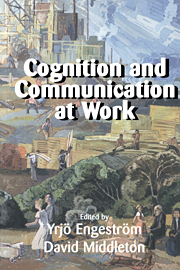Book contents
- Frontmatter
- Contents
- Contributors
- Acknowledgments
- 1 Introduction: Studying work as mindful practice
- 2 Distributed cognition in an airline cockpit
- 3 Constituting shared workspaces
- 4 Seeing as situated activity: Formulating planes
- 5 Convergent activities: Line control and passenger information on the London Underground
- 6 Users and designers in mutual activity: An analysis of cooperative activities in systems design
- 7 System disturbances as springboard for development of operators' expertise
- 8 Expert and novice differences in cognition and activity: A practical work activity
- 9 The tensions of judging: Handling cases of driving under the influence of alcohol in Finland and California
- 10 Talking work: Argument, common knowledge, and improvisation in teamwork
- 11 The collective construction of scientific genius
- 12 Experience and the collective nature of skill
- 13 Working together: Symbolic interactionism, activity theory, and information systems
- 14 On the ethnography of cooperative work
- Index
5 - Convergent activities: Line control and passenger information on the London Underground
Published online by Cambridge University Press: 05 June 2012
- Frontmatter
- Contents
- Contributors
- Acknowledgments
- 1 Introduction: Studying work as mindful practice
- 2 Distributed cognition in an airline cockpit
- 3 Constituting shared workspaces
- 4 Seeing as situated activity: Formulating planes
- 5 Convergent activities: Line control and passenger information on the London Underground
- 6 Users and designers in mutual activity: An analysis of cooperative activities in systems design
- 7 System disturbances as springboard for development of operators' expertise
- 8 Expert and novice differences in cognition and activity: A practical work activity
- 9 The tensions of judging: Handling cases of driving under the influence of alcohol in Finland and California
- 10 Talking work: Argument, common knowledge, and improvisation in teamwork
- 11 The collective construction of scientific genius
- 12 Experience and the collective nature of skill
- 13 Working together: Symbolic interactionism, activity theory, and information systems
- 14 On the ethnography of cooperative work
- Index
Summary
[T]he relevance of the works of the Chicago sociologists is that they do contain a lot of information about this and that. And this and that is what the world is made up of.
Sacks, H. (1964/1992, p. 27)“Shared Agreement” refers to various social methods for accomplishing the member's recognition that something was said according to a rule and not the demonstrable matching of substantive matters. The appropriate image of a common understanding is therefore an operation rather than a common intersection of overlapping sets.
Garfinkel, H. (1967, p. 30)Introduction
Some of the finest work within the sociology of organizations began to emerge from Chicago following the second world war. Due in no small way to the lectures and essays of E. C. Hughes, social science witnessed the emergence of a substantial body of naturalistic studies of work and occupations that began to delineate the practices and reasoning that provide the foundation for tasks and interpersonal communication throughout a range of organizational settings. Hughes and his colleagues powerfully demonstrated through numerous empirical studies how organizational life is thoroughly dependent upon and inseparable from a tacit and emergent “culture” that is fashioned and continually refashioned in the light of the problems that personnel face in the routine accomplishment of their day-to-day work (see, for example, Hughes, 1958, 1971; Becker et al., 1961; Goffman, 1968; Roth, 1963; Strauss et al., 1964).
- Type
- Chapter
- Information
- Cognition and Communication at Work , pp. 96 - 129Publisher: Cambridge University PressPrint publication year: 1996
- 71
- Cited by



